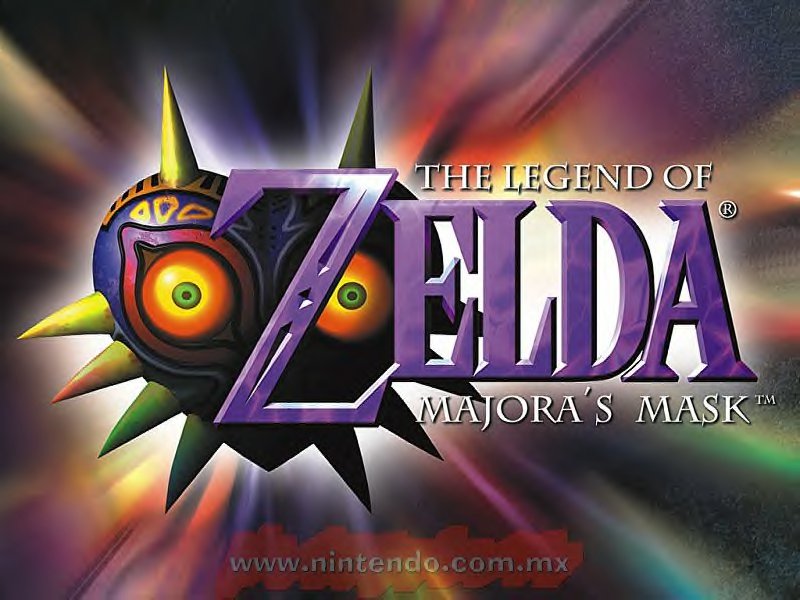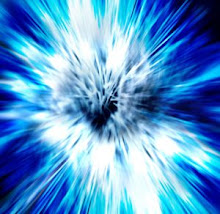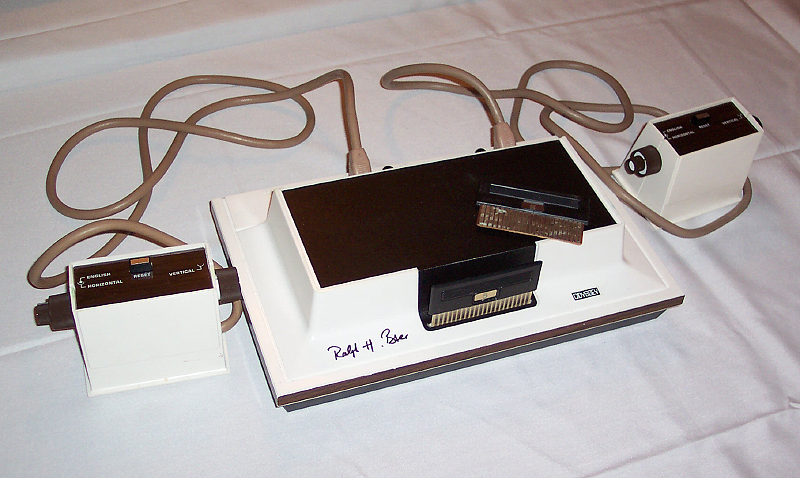Wednesday, August 25, 2010
Review 17: Azurik: The Rise Of Perathia (XBOX)
And now, for one of the most underrated games of all time. Azurik was released for the original Xbox as a launch title, and when it was released, it didn't get many good reviews. Most reviewers thought the environment was horrible, the controls were clunky (etc.). However, if you dive deeper into this game, you will find that it's not so bad after all.
Story: 7/10
The story is a little original, if not cliche. In the land of Perathia, there are six Realms: the Water Realm, the Earth Realm, the Fire Realm, the Air Realm, the Life Realm and the Death Realm. Six corresponding disks bring balance to all of these realms. The Death Disk, though, had been lost a long time ago, but still everything is fine. Guardians protect the land from enemies as well as the disks, keeping the peace.
The story starts when you, a young guardian named Azurik, are training. Another guardian, named Balthazar, challenges you to a fight and nearly kills you. It should be noted here that Balthazar is greedy, and strives for power. However, the Master, Eldwin, stops him. Bitter, Balthazar breaks a wall of the training room and finds the Death Disc. He brings it to his home, and there, the Guardian of the Death Disc possesses him.
Later, Azurik and Eldwin are on top of a tower where the Discs are located. Suddenly, Balthazar, influenced by the Death Guardian, kills Eldwin and breaks all of the disks into pieces, scattering them all over the realm. After this event, the balance of Perathia has been shattered. Now Azurik must locate all of the Disk fragments, stop Balthazar and bring the balance back to Perathia.
I've got to admit, this sounds like something you'd hear in your regular 1995 RPG. However, some bits are original enough, which is why I'm giving it a higher rating.
Gameplay: 9/10
Now onto the gameplay. This is where it gets interesting. Your weapon in this game is the Axiom, a staff which can harness the powers of Earth, Water, Fire and Air, which are each collected at different points in the game. It can also mix these powers to create new elements: Acid, Lava, Whirlwind and a shield are just a few of these things. I think the team was being really creative here, as there are a lot of combinations that can be made with four starting points.
The Axiom will have to be used a lot, though, as it's a big world out there! The main thing you'll have to be doing in this game is exploring. You can visit all six realms mentioned above, as well as a "hub" where a small town, which seems to be the only living spot for humanoids such as Azurik, is located. But 6 realms means that they're all going to be small, right? Wrong. Every realm save for those of Life and Death have at least 4 separate areas, each with their own style: for example, the Water Realm has an area with an Ice theme, one with a Stormy theme, and 2 with a normal grassy and stony theme. These areas are large in themselves, as well, so it'll take a long, long, long time trying to find all of the Disk Fragments. But I guess that's just part of the challenge, too, and in some ways I actually like it.
And then there are the enemies. The pesky, pesky enemies. Especially in the Air Realm, where most of the time there isn't much space not to get knocked down, the enemies will be lots of trouble in this game. There are Blaze Sentinels which shoot fire at you, a problem if there are other pesky enemies around you, Harvesters, which come in packs, and Golems, big lugs that take a lot of time to kill. Worse, every time you die, every single enemy regenerates too, and although that may not sound like a problem, trust me, it is. Most times, the enemies swarm up on you, and you'll probably get hit at least once in the scuffle, even if you're a good player.
Finally, there are the puzzles and mini-games. There are a variety of them in this game, including a mini-game at the beginning where you must move the control stick to put out a fire before parts of it reform, various parts of the game where you must find a few "keys" to unlock new sections of a realm, a puzzle at the end of the game where you must move an elevator to multiple places to get to the final boss, and more. Not all of these are welcome, though; the Elevator puzzle is confusing and would probably take a long time to figure out, and one mini-game at the very end of the Life Realm, in which you use a cannon to try to shoot the cores out of 20 satellites while avoiding yellow trails, is considered by many to be the hardest part of the game.
All in all, I very much enjoyed the gameplay of Azurik. It's creative, fun, and it'll take a long time before you get through everything, although it could have gone without some of the enemy placements and puzzles.
Graphics: 10/10
This game's graphics were absolutely stunning for its time. Azurik was one of the first game to ever use anti-aliasing, which made sure that the models or environments didn't look strange. On top of that, the Xbox's hardware made the graphics be able to look their finest, even without HD. The water in the Water Realm has the exact same color you would find in a regular lake, and the waves are very realistic as well. In the Ice area of the Water Realm, Azurik even has steam coming out of his mouth! The team did very well in making good graphics especially for the early 2000s, whether they were the environments or the smaller things that made the background all that more appealing.
Music: 9/10
For the most part, Azurik used composed music directly from an orchestra. Although I don't really listen to that type of music, I have to say, the composers definitely put everything in place. The theme for the Earth Realm is very straightforward and down to earth (no pun intended) like a rock, the song for when you're fighting in the Fire Realm sound intense and random, like fire, one of the Air Realm themes sounds heavenly like clouds, and one of the themes for the stormy part of the water realm sounds unsettled, just like a real storm. Even though I didn't really listen to many of the themes when playing through the game, they still sounded good in the background, and made the game much more enjoyable than if there had been no music at all.
Replay Value: 7/10
The length of this game has different responses: For some people, such as me, it's good because it means I can keep on playing as long as I want and even if I complete it, I'll still probably be surprised at some other point of playing it again, because I will have forgotten it. For some people, though, they're turned off by the length, and they wouldn't want to have to go through all that trouble just to complete one game. Personally, I think that to reward the players, they should have made a menu for all of the hidden cheat codes in the game (yes, there are some), maybe have made an Endless Battle mode to fight every enemy until you die, or at least have had a "New Game +" type of mode where you started with all of your elements. But that's just me. I don't think most people would be compelled to play this game with the same thing again, mainly because of its length, which is why I'm giving it a lower rating.
Overall: 8/10
There are definitely some things that they could have done better with this game, but when it comes down to it, this game really is great. The gameplay is creative and fun for the most part, the music is good, and the graphics are just stunning. I find it a shame that no sequel has been released yet, but it's probably because of most of the other reviewers who have rated it so low. Well, I'm reviewing this game too, and I have something to say: This game is amazing.
Posted by MEMYSELF at Wednesday, August 25, 2010 3 comments
Monday, August 23, 2010
Review 16: Balloon Fight (NES)
Balloon Fight is a game that was released in Japan on January 22, 1985. Featuring an unnamed Balloon Fighter, it has had numerous ports and remakes made for it, including one featuring the character Tingle from The Legend Of Zelda. So what this game all about? Let's find out.
Gameplay: 8/10
There are three modes in this game: 1 Player Mode, 2 Player Mode and Balloon Trip. 1 Player Mode is the main mode, in which you start with three lives. In it, you can use the control pad to go left or right and repeatedly press the A or B buttons to go up. If you stop pressing the button(s), the Balloon Fighter goes down. The point of the game is to pop all of the enemy Balloon Fighter's balloons by bumping into the balloons and then knocking them down, while at the same time not allowing them to pop your two balloons, in which case you will lose a life. It is also possible to lose a life by accidentally falling into water, getting eaten by a fish if you're too close to said water, or getting hit by lightning.
At the same time, like any other good NES game, there is a points system. Points can be earned by popping enemy balloons, knocking the enemy down, popping the bubbles which appear after the fallen enemy is off the screen, or by popping balloons (without a fighter) in a bonus round, which happens after every 2 stages.
The next mode is the 2 Player Mode. It is exactly the same as the first mode, except a second player can join in for a co-operative game, meaning you can't pop the balloons of the other player. The only thing about these two modes are the controls: When you first get into the air, it's extremely hard to move left or right, and although that changes after a while, it makes stopping hard as well, even if you're trying to flap in the opposite direction.
Finally, the last mode is Balloon Trip. It could be considered as a different game altogether, as the gameplay is very different than the first one: Here, the screen is side-scrolling, and the objective is to collect as many balloons as you can while not falling too deep or touching any of the lightning sparks. You only start off with one life in this mode, making it even more difficult.
All in all, the gameplay of this game is very addictive, and having an extra, completely different mode certainly doesn't hurt it at all.
Graphics: 7/10
The graphics here certainly aren't the best, but they're not too bad either; as in, not as good as the graphics of Super Mario Brothers 3, but better than that of Super Mario Brothers. Not much else to say here.
Music: 6/10
The main problem in this game is that during most of the game, you will not hear any music. Instead, you will hear a bunch of high-pitched noises as you flap around and try to get the enemy, which can be a little annoying at times. To my knowledge, the only background music is the music that plays in the bonus round/Balloon Trip mode, and although it's catchy, it's not enough to give the "soundtrack" a good rating.
Replay Value: 10/10
This is one of those games that has an addictive quality as soon as you start playing. Somehow, to me popping balloons while not trying to get popped yourself is pretty dang fun, and it makes you want to get as far as you possibly can in the game, which also goes with Balloon Trip. There's just something about it that makes you not want to stop.
Overall: 8/10
Marred only by its lack of a soundtrack and difficult controls, Balloon Fight is a great game that is vastly underrated. It has overall good gameplay, three modes and a great addictive quality, so why not get it? It's available on the Virtual Console for only 500 Wii Points.
Posted by MEMYSELF at Monday, August 23, 2010 1 comments
Tuesday, August 10, 2010
Review 15: Mega Man 2 (NES)
Posted by MEMYSELF at Tuesday, August 10, 2010 0 comments
Friday, March 5, 2010
Spinout Server?
You've probably seen the pop-up box telling you to sign in to the server at spinout182.com. I have no idea what this is, or why it's there. I've contacted Spinout182 on Youtube about this... no answer. If anyone actually reads this blog, then just click cancel. I'm probably going to move to my own domain soon, so this problem shouldn't last long (along with all the other problems of this blog).
Posted by MEMYSELF at Friday, March 05, 2010 0 comments
Monday, December 7, 2009
Review 14: The Legend Of Zelda: Majora's Mask (N64)
Majora's Mask is the sequel to the groundbreaking first 3D Zelda game, Ocarina of Time. Originally released to the public on May 27, 2000, Majora's Mask was stunningly different from its predecessors. Read on and find how.
Story: 10/10
While in the Lost Forest riding his horse, Epona, Young Link from OoT comes across a Skull Kid wearing a mysterious mask and his two fairies, Tael and Tatl. They steal Epona and the Ocarina of Time from Link and disappear into a dark cave. Link follows and, when the Skull Kid finds him, he turns Link into a Deku Scrub. When Tatl gets separated from Tael, her brother, she has no choice but to team up with Link.
Later on, Link finds a mysterious man, the Happy Mask Salesman, who tells him it is possible to get his human form back; he must only get the item that was stolen from him (The Ocarina of Time), and in exchange, Link must get the item stolen from the Salesman, Majora's Mask, which the Skull Kid has donned. Link adventures in a new town, Clock Town, to find out a way to get back his human form, while hearing about the impending doom that is to come to the alternate version of Hyrule he is in, named Termina, in three days.
On the midnight of the third day, Link and Tatl manage to corner the Skull Kid in the Clock Town tower, moments before he crashes the freaky-looking moon on all of Termina, and Link makes the Ocarina of Time fall out of his hand. Link remembers when Princess Zelda taught him the Song of Time to manipulate the flow of Time, and plays it. Suddenly, time is reversed for both Link and Tatl, and they warp back to the dawn of the first day and see the Happy Mask Salesman. He teaches Link the Song Of Healing, able to turn troubled spirits into masks, and turns Link's Deku form into a mask, bringing him back to human form.
However, upon learning that Link has failed to bring back Majora's Mask, the Salesman goes into a rage, telling him how powerful and dangerous the mask is and that he must bring it back before he travels to another far-off land, on the eve the Moon will crash on Termina. The two leave. Tatl remembers that in the tower, Tael said something important:
"Swamp. Mountain. Ocean. Canyon. Hurry... The four who are there... Bring them here..."
Armed with this small knowledge, Link and Tatl race to find "the four" and Majora's Mask while rewinding, slowing down and even speeding up time using Link's Ocarina. Many things will happen in this dangerous and nightmarish journey...
Gameplay: 10/10
Like just about all other Zelda games, you play as Link.You mash up some baddies, get some Pieces of Heart, use up your Magic Meter, most of what you've seen in Ocarina of Time... except for two very important new gameplay devices. These features are the time system and masks.
First, let's go over the time system. As mentioned above, you only have three days to stop the Skull Kid before he dooms Termina. Also stated above, you can easily change that by manipulating the flow of time with three songs: the Song of Time, which rewinds time to the dawn of the first day (6:00), the Inverted Song of Time (a backwards version), which slows down time, and the Song of Double Time, which makes time switch to the next time period (the dawn of the first day switches to the night of the first day, the night of the first day switches to the dawn of the second day, etc.). A crucial thing to remember is that when you play the Song of Time, you will keep all your important items (Masks, the Ocarina, etc. ) but you will lose your Rupees (the currency in the Zelda series)and your other items. Dungeons you have cleared and chats with most people will be reverted to their original state as well.
Time is viewed by a semicircle-shaped timer, located at the bottom of the screen. Here's a picture:
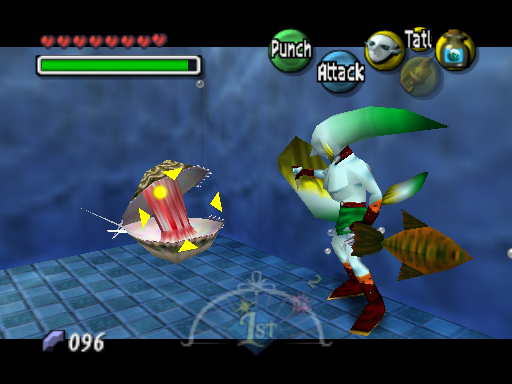
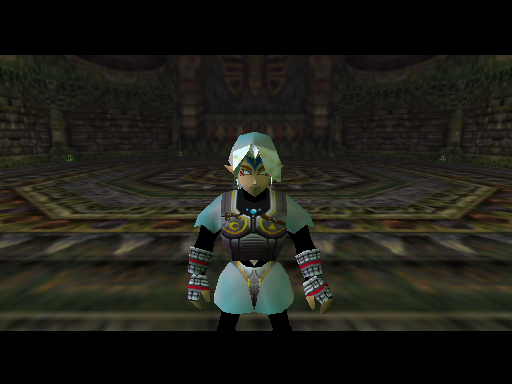
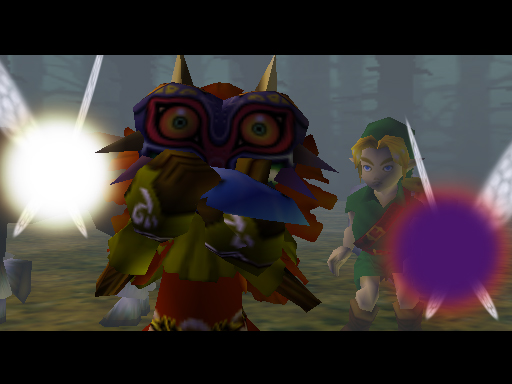

Posted by MEMYSELF at Monday, December 07, 2009 0 comments
Wednesday, November 25, 2009
Review 13: Sonic The Hedgehog (Sega Master System)
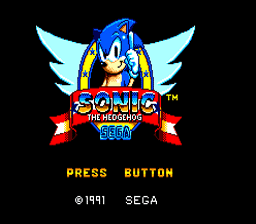
Gameplay: 8/10
The gameplay in this port is generally the same as its counterpart: run, spin jump, collect rings and on some occasions defeat the evil Dr. Ivo Robotnik in zones divided up into 3 acts. However, there are a few differences, most negative. For starters, the game is much slower than the Genesis version, most likely because the Master System couldn't handle it. Also, the levels are much more straightforward and less psychedelic- heck, there aren't any loop-de-loops. However, there are less badniks- enemy animals in robotic shells- to oppose you, a positive covered up by the fact that you cannot pick up your rings once you get hit. That's right. Get hit once, and you can't regain health unless you find other rings. There are six zones in this port: Green Hill Zone, Labyrinth Zone and Scrap Brain Zone from the original, and three totally new (well, I guess you would call it old now) zones, Bridge Zone, Jungle Zone and Sky Base Zone for this one, with completely different layouts. And finally, another difference is that the Chaos Emeralds, as opposed to being in the special stages in the Genesis version, are hidden in one of the two non-boss acts in the zones.

16-bit

8-bit

16-bit
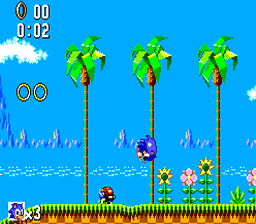
8-bit

16-bit

8-bit
Music: 10/10
The music sounds pretty good when converted to 8-bit style. Including favorites such as the Green Hill Zone theme, this game also has brand new songs for the new zones instead of just ripping the soundtrack from the original and converting it for the Master System. Something notable is that the Bridge Zone music (my personal favorite, by the way) is essentially the same thing as Believe In Myself, Tails' theme from Sonic Adventure 2.
Overall: 9/10
This port is more than a port. It actually feels more like a standalone game, what with new zones, new music and the other gameplay changes stated above. This is a true Sonic game.
Available in Wii Shop Channel for: 500 Wii Points
Posted by MEMYSELF at Wednesday, November 25, 2009 1 comments
Tuesday, November 17, 2009
Review 12: Super Mario All-Stars (SNES)
Released on July 14, 1993 in Japan, Super Mario All-Stars was a compilation of the games Super Mario Bros. , Super Mario Bros. 2, Super Mario Bros 3 and Super Mario Bros. : The Lost Levels (also known as Super Mario Bros. 2 in Japan) with upgraded graphics, game play, and removal of glitches, a later release featuring Super Mario World. The game has been praised by critics, and was a "Player's Choice" game for the SNES.
Gameplay: 10/10
One classic Mario game is good enough, but four is far too great for words. All of these remakes play almost exactly as you would expect that game to play: SMB is all about jumping on Goombas, getting Super Mushrooms, finding out the Princess is in another castle, etc. SMB 2 has you defeat Wart and his minions using veggies (ain't that a message), and SMB 3 takes you to all sorts of worlds, whether icy, water-filled, or sandy. The Lost Levels weren't released in the West until this game, so in case you're wondering, it's just like the original, only ten times more tedious. This game featured Poison Mushrooms, fake Bowsers that you do not need to defeat, and reverse warp zones.
Graphics: 10/10
This release really gave all the games a major overhaul. Even the Bros. themselves are totally different than from their palette-swapping days. The backgrounds are more detailed, the enemies were updated- This is no mere assortment of the originals. It's all original from this game. And I don't care if it doesn't stand up to the graphics of other SNES games; it doesn't need to.
Photos:
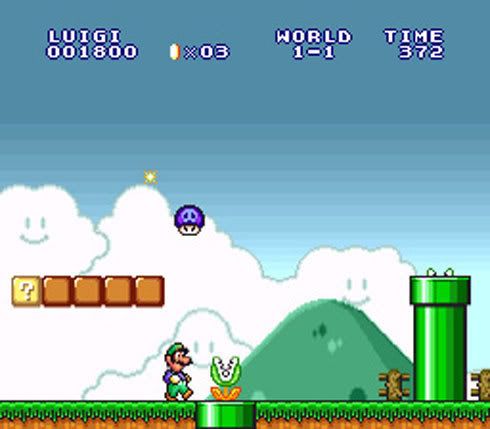
The Lost Levels (as identified by the Poison Mushroom)
Super Mario Bros. 3
.png)
Super Mario Bros. 2

Super Mario Bros.
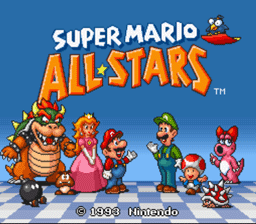
Title Screen

Title Screen (when you got it with Super Mario World)
Music: 9/10
The music in this remake is also revamped; practically all the tunes you've loved all those years are available in the clearer sound system (or something) of the SNES. You can hear the Overworld Theme, the Underground theme, the Castle theme, the Hammer Bros. theme- whatever theme you want. And plus, Nintendo has even sneaked in a few new themes for you to enjoy.
Overall: 10/10
This game has every right to be a Player's Choice game. It'll bring the nostalgia right back to you- and bring with it something more.
Available in the Wii Shop Channel for: N/A
Posted by MEMYSELF at Tuesday, November 17, 2009 1 comments


.jpg)
